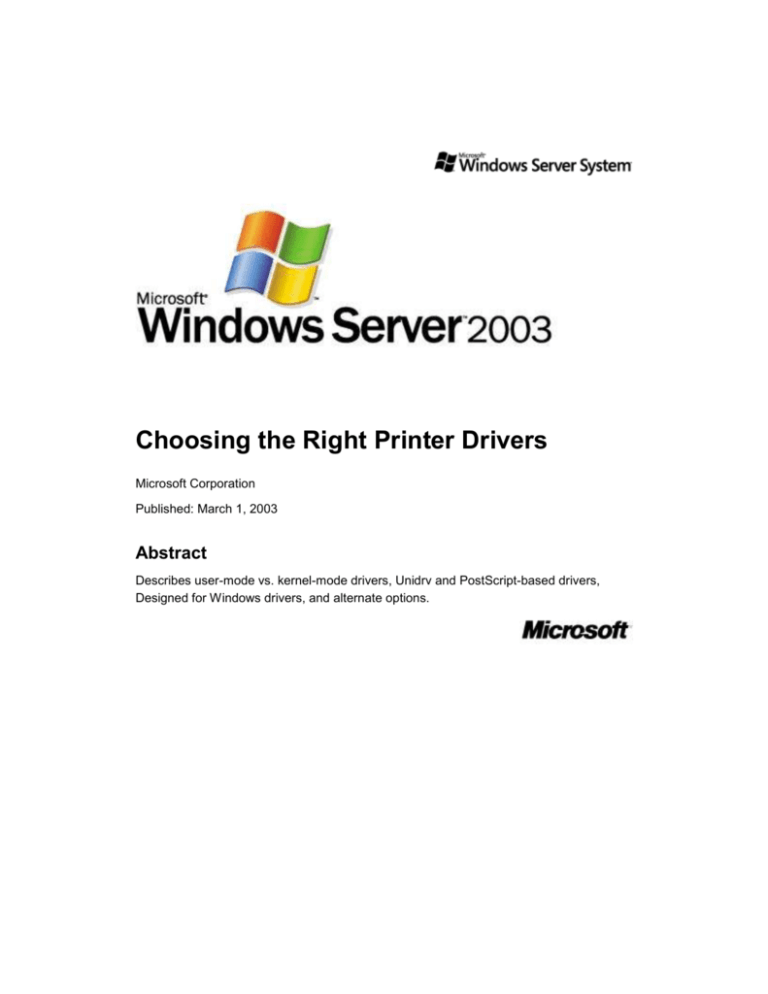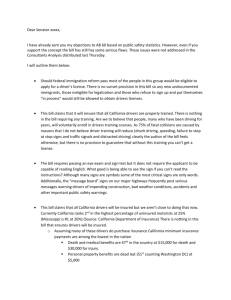
Choosing the Right Printer Drivers
Microsoft Corporation
Published: March 1, 2003
Abstract
Describes user-mode vs. kernel-mode drivers, Unidrv and PostScript-based drivers,
Designed for Windows drivers, and alternate options.
Information in this document, including URL and other Internet Web site references, is
subject to change without notice. Unless otherwise noted, the example companies,
organizations, products, domain names, e-mail addresses, logos, people, places, and
events depicted herein are fictitious, and no association with any real company,
organization, product, domain name, e-mail address, logo, person, place, or event is
intended or should be inferred. Complying with all applicable copyright laws is the
responsibility of the user. Without limiting the rights under copyright, no part of this
document may be reproduced, stored in or introduced into a retrieval system, or
transmitted in any form or by any means (electronic, mechanical, photocopying,
recording, or otherwise), or for any purpose, without the express written permission of
Microsoft Corporation.
Microsoft may have patents, patent applications, trademarks, copyrights, or other
intellectual property rights covering subject matter in this document. Except as expressly
provided in any written license agreement from Microsoft, the furnishing of this document
does not give you any license to these patents, trademarks, copyrights, or other
intellectual property.
© 2005 Microsoft Corporation. All rights reserved.
Microsoft, Windows, Windows NT, and Windows Server are either registered trademarks
or trademarks of Microsoft Corporation in the United States and/or other countries.
All other trademarks are property of their respective owners.
Contents
Choosing the Right Printer Drivers ..................................................................................... 1
Abstract ........................................................................................................................ 1
Contents .............................................................................................................................. 3
Introduction (Choosing the Right Printer Drivers) ............................................................... 5
User-mode vs. Kernel-mode Drivers ................................................................................... 6
Unidrv and PostScript-based Drivers .................................................................................. 7
Designed for Windows Drivers ............................................................................................ 7
Alternate Options ................................................................................................................ 8
Summary (Choosing the Right Printer Drivers)................................................................... 9
Related Links (Choosing the Right Printer Drivers) ............................................................ 9
5
Introduction (Choosing the Right Printer
Drivers)
The Microsoft Windows printing architecture consists of a print spooler and a set of
printer drivers. By calling device-independent Win32 printing and Graphics Device
Interface (GDI) functions, applications can create print jobs and send them to any of a
variety of devices, including laser printers, vector plotters, raster printers, and fax
machines. Printer drivers include a user interface (UI) component that allows users to
control a printer's selectable options.
An application's calls to Win32 GDI functions are passed to the GDI graphics engine,
which either spools the drawing instructions as an enhanced metafile (EMF) or, in
conjunction with a printer driver, renders a printable image that can be sent to the
spooler. Spooler components interpret EMF files, and they can insert page layout
information and job control instructions into the data stream. The spooler then sends the
data stream to the serial, parallel, USB, or network port driver associated with the target
printer's I/O port. The device interprets the job, formatted in Printer Description Language
(PDL) for the device, and outputs the printed document.
The printer drivers that you select to run on your Windows 2003 print server can have a
great impact on its performance, reliability, and scalability.
Printer performance and reliability can be improved by selecting robust, well-tested
drivers. These drivers are less likely to crash and therefore require less maintenance by
the print administrator.
Scalability is affected by the quantity of unique drivers on a specific server. By reusing
the same driver for multiple printers, you lower the chances that drivers will interact in a
negative way and reduce the amount of spooler process and registry space used.
The following types of drivers, explained in detail later in this document, are
recommended for achieving the optimal performance, reliability, and scalability goals:
User-mode drivers
Unidrv-based drivers
PostScript drivers
Drivers with the Designed for Windows logo
The following driver types should be avoided unless there are no other options:
6
Kernel-mode or Microsoft Windows NT 4.0 drivers
Monolithic drivers (that is, neither a Unidrv nor PostScript-based driver)
Drivers without the Designed for Windows logo (unsigned drivers)
User-mode vs. Kernel-mode Drivers
Drivers can be written in either user mode (also called version 3 drivers) or kernel mode
(also called version 2 drivers). In Windows NT 4.0, drivers were moved into kernel mode
to improve performance. However, when a kernel-mode driver fails, it can crash an entire
system, whereas the failure of a user-mode driver causes only the current process to
crash. Because of this difference, and because performance enhancements were made
in Windows 2000 and Windows Server 2003, native drivers on Windows 2000 and later
run in user mode. Windows Server 2003 can still run kernel-mode drivers, although this is
not recommended for the stability reasons mentioned previously. It is also possible to
install kernel-mode drivers using the Additional Drivers option on Windows 2003 print
servers to support Windows NT 4.0 clients.
All drivers on the Windows Server 2003 CD are user mode, except those in the
printers\nt4\i386 directory, which are kernel mode to support Windows NT 4.0 clients.
To check whether a driver that you have installed is user mode or kernel mode, do the
following:
1. Click Start, and then choose Printers Folder.
2. Click File, and then click Server Properties.
3. Click the Drivers tab.
4. Look at the Version column for a specific driver. If the version indicates Windows NT
4.0 you have a kernel-mode driver. If the version is Windows 2000, Windows XP and
Windows Server 2003, you have a user-mode driver.
Note
The Server Properties dialog box contains information and settings about the
entire print server.
7
Unidrv and PostScript-based Drivers
Unidrv and Postscript are the standard, well-tested core rendering engines included in
Windows Server 2003. In addition, there is a core plotter driver in Windows Server 2003
which a few drivers use. All drivers included on the Windows Server 2003 CD are based
on the PostScript, plotter or Unidrv-based drivers, the majority of which were written in
conjunction with Independent Hardware Vendors (IHVs) and are also available on the
IHVs independent Web sites. These full-featured drivers are supported by both Microsoft
and the IHVs.
Because approximately 3,800 drivers based on Unidrv or PostScript are included on the
Windows Server 2003 CD and have been thoroughly tested by Microsoft, the IHVs, and
multiple customers, these core engines have been proven to be reliable and stable.
Drivers based on these engines are less likely to have problems than those based on
monolithic engines.
To determine whether a driver you have installed is using the Unidrv or Postscript
rendering engines, do the following:
1. Click Start, and then choose Printers Folder.
2. Click File, and then click Server Properties.
3. Click the Drivers tab.
4. Select a driver, and then click Properties.
5. Look at the Driver File list box of in the Driver Properties dialog box. If UNIDRV.DLL
or PSCRIPT5.DLL appears, the driver is using one of these rendering engines.
Note
The Postscript rendering engine was co-written by Microsoft and Adobe
Systems. You can find the same PostScript engine on the Adobe Web site
(http://www.adobe.com) as is on the Windows Server 2003 CD. PostScript 5.1
was included in Windows 2000. PostScript 5.2 is included in Windows 2000 SP3
and Windows Server 2003.
Designed for Windows Drivers
The "Designed for Windows" logo identifies hardware and software products that have
been designed and tested to meet Microsoft standards for compatibility with the Windows
Server 2003 operating system. Products displaying the logo have passed rigorous testing
8
that assures they are easy to use, stable, and take advantage of the new features of
Windows Server 2003. Hardware is tested to specifications set by the Windows
Hardware Quality Labs (WHQL).
Businesses that use products meeting the Designed for Windows logo criteria stand to
gain the following benefits:
Lower support costs: Drivers with the logo follow standard Windows look-and-feel
guidelines. A consistent UI helps users get up to speed without phoning the help
desk.
Help manage "DLL Hell": Drivers with the logo do not overwrite other drivers or
uninstall key components.
Proper use of operating system: Products with the logo make proper use of the
Windows registry and other key operating system files.
Compliance with the Americans with Disabilities Act and other equal rights
legislation: Products with the logo meet usability standards for a wide range of
people.
A list of all drivers that currently have the Designed for Windows logo is available at
http://www.microsoft.com/whdc/hcl/default.mspx.
Note
Most but not all drivers with the Designed for Windows logo are user-mode
drivers. All drivers recently granted the Designed for Windows Server 2003 logo
are user-mode drivers. However, some kernel-mode drivers with proven reliability
were grandfathered in during the initial stages of the logo process during the
release of Windows 2000.
Alternate Options
If you are unable to find user-mode drivers with the Designed for Windows logo that are
based on the Unidriver or PostScript engines, try using a compatible driver for your
printer that supports a majority of the important features. For more information, see the
Print Server Upgrade, Migration, and Interoperability white paper at
http://www.microsoft.com/windows2000/technologies/fileandprint/print/default.asp.
9
Summary (Choosing the Right Printer
Drivers)
As described in the preceding sections, the drivers chosen to run on your print server can
affect the stability, reliability, and performance of the server. For best performance, look
for user-mode drivers with the Designed for Windows logo that are Unidrv or Postscript
based drivers.
Related Links (Choosing the Right
Printer Drivers)
See the following resources for further information:
For more information about deployment and management of Windows print servers,
see the Windows Server 2003 Deployment Kit.
For information about the point-and-print architecture, see the Windows Point and
Print Technical Overview white paper.
For more information about the Windows .NET architecture, see the Display and Print
Devices sections in the Windows Driver Development Kit.
For more information about Windows Print Services in general, visit the Print
Services Technology Center.
For the latest information about Windows Server 2003, see the Windows Server 2003
Web site.






